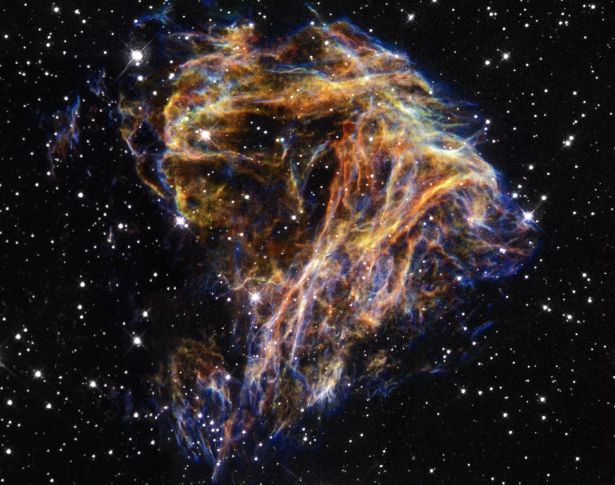Explanation: Scattered debris from a cosmic supernova explosion lights up the sky in this gorgeous composited image based on data from the Hubble Space Telescope. Cataloged as N49, these glowing filaments of shocked gas span about 30 light-years in our neighboring galaxy, the Large Magellanic Cloud. Light from the original exploding star reached Earth thousands of years ago, but N49 also marks the location of another energetic outburst -- an extremely intense blast of gamma-rays detected by satellites on March 5, 1979. That date marked the beginning of an exciting journey in astrophysics which led researchers to the understanding of an exotic new class of stars. The source of the "March 5th Event" is now attributed to a magnetar - a highly magnetized, spinning neutron star also born in the ancient stellar explosion which created supernova remnant N49. The magnetar hurtles through the supernova debris cloud at over 1,200 kilometers per second.
1999 2000 2001 2002 2003 2004 2005 2006 2007 2008 2009 2010 2011 2012 2013 2014 2015 2016 2017 2018 2019 2020 2021 2022 2023 2024 2025 |
Yanvar' Fevral' Mart Aprel' Mai Iyun' Iyul' Avgust Sentyabr' Oktyabr' Noyabr' Dekabr' |
NASA Web Site Statements, Warnings, and Disclaimers
NASA Official: Jay Norris. Specific rights apply.
A service of: LHEA at NASA / GSFC
& Michigan Tech. U.
|
Publikacii s klyuchevymi slovami:
N 49 - magnetar - supernova remnant - soft gamma repeater - Magnitary - ostatok Sverhnovoi - gamma-izluchenie
Publikacii so slovami: N 49 - magnetar - supernova remnant - soft gamma repeater - Magnitary - ostatok Sverhnovoi - gamma-izluchenie | |
Sm. takzhe:
Vse publikacii na tu zhe temu >> | |
